Project: Analyzing DoD Frameworks and IT Infrastructure Security
VerifiedAdded on 2022/09/07
|6
|864
|20
Project
AI Summary
This project analyzes the Department of Defense Architecture Framework (DoDAF) version 2.0, a crucial framework used by the U.S. Department of Defense for visualizing, understanding, and managing complex systems with interoperability and integration challenges. The DoDAF employs various vie...
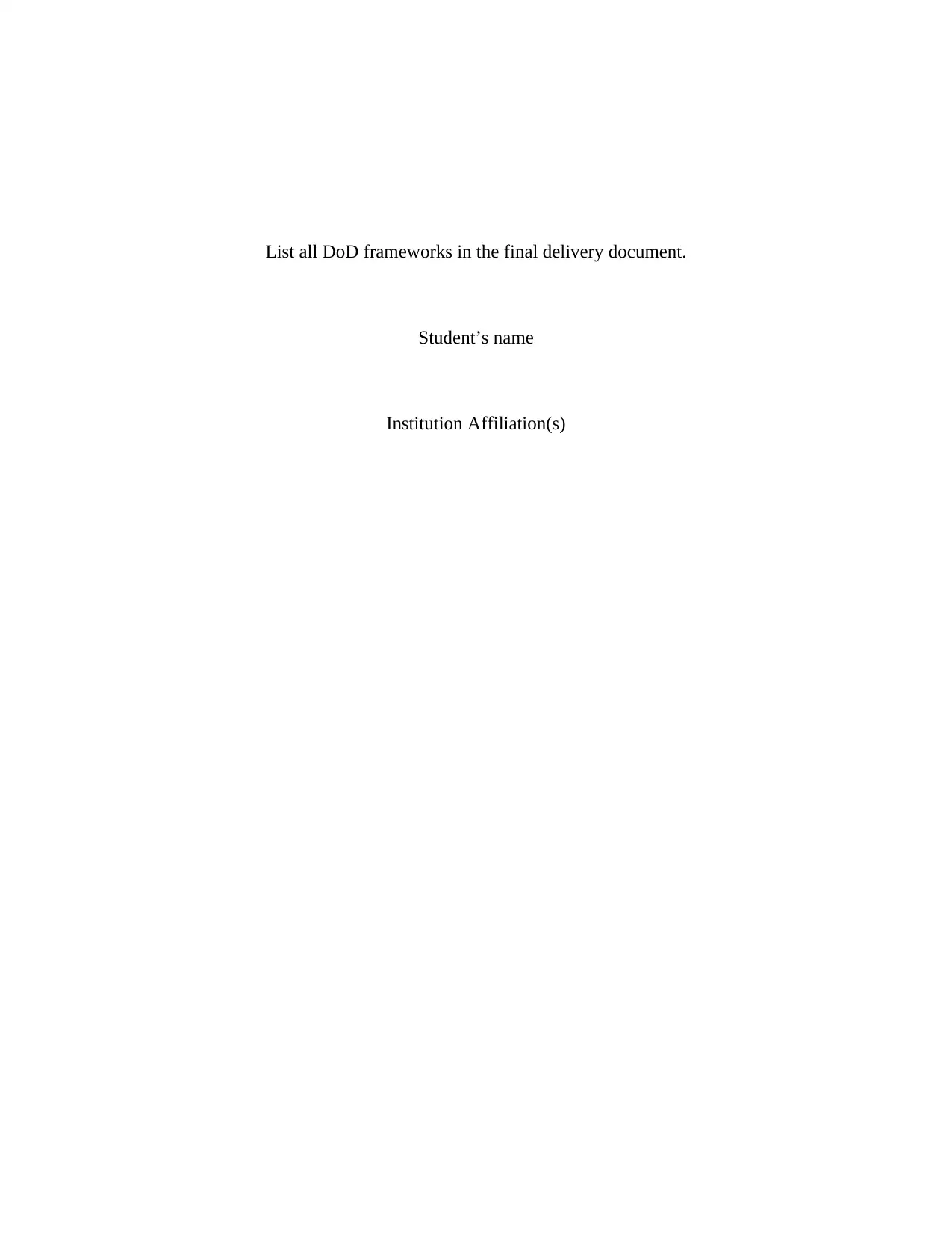
List all DoD frameworks in the final delivery document.
Student’s name
Institution Affiliation(s)
Student’s name
Institution Affiliation(s)
Paraphrase This Document
Need a fresh take? Get an instant paraphrase of this document with our AI Paraphraser
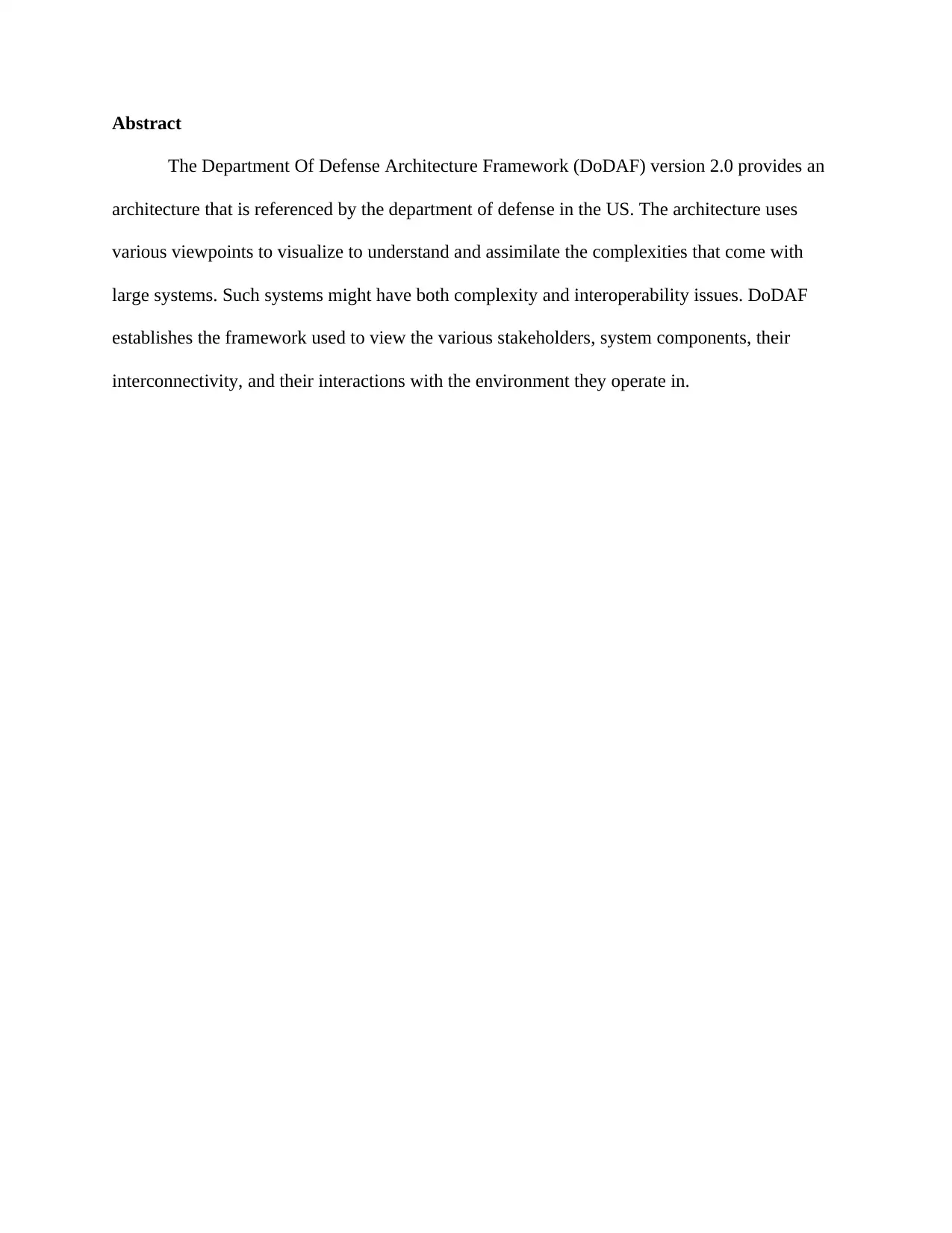
Abstract
The Department Of Defense Architecture Framework (DoDAF) version 2.0 provides an
architecture that is referenced by the department of defense in the US. The architecture uses
various viewpoints to visualize to understand and assimilate the complexities that come with
large systems. Such systems might have both complexity and interoperability issues. DoDAF
establishes the framework used to view the various stakeholders, system components, their
interconnectivity, and their interactions with the environment they operate in.
The Department Of Defense Architecture Framework (DoDAF) version 2.0 provides an
architecture that is referenced by the department of defense in the US. The architecture uses
various viewpoints to visualize to understand and assimilate the complexities that come with
large systems. Such systems might have both complexity and interoperability issues. DoDAF
establishes the framework used to view the various stakeholders, system components, their
interconnectivity, and their interactions with the environment they operate in.
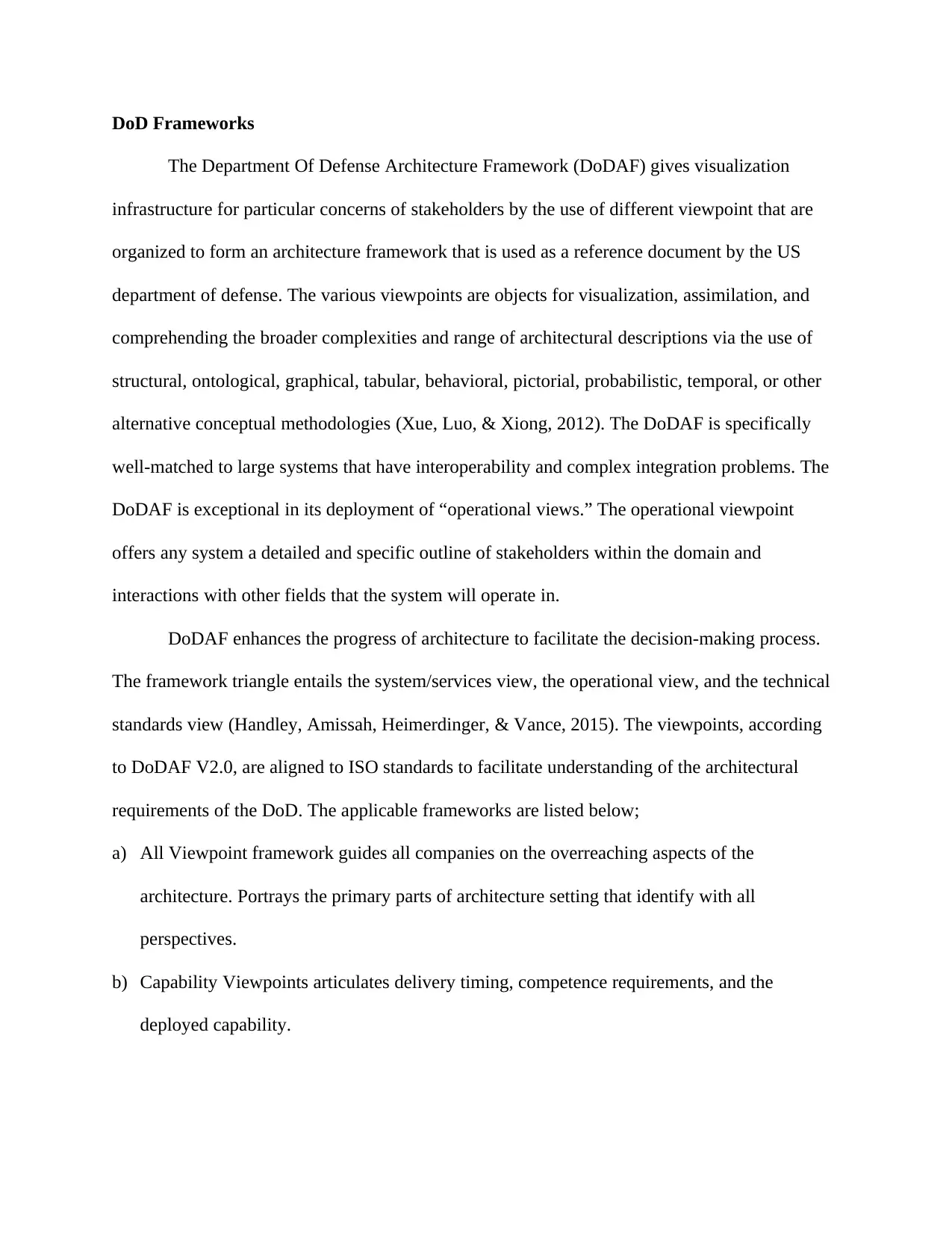
DoD Frameworks
The Department Of Defense Architecture Framework (DoDAF) gives visualization
infrastructure for particular concerns of stakeholders by the use of different viewpoint that are
organized to form an architecture framework that is used as a reference document by the US
department of defense. The various viewpoints are objects for visualization, assimilation, and
comprehending the broader complexities and range of architectural descriptions via the use of
structural, ontological, graphical, tabular, behavioral, pictorial, probabilistic, temporal, or other
alternative conceptual methodologies (Xue, Luo, & Xiong, 2012). The DoDAF is specifically
well-matched to large systems that have interoperability and complex integration problems. The
DoDAF is exceptional in its deployment of “operational views.” The operational viewpoint
offers any system a detailed and specific outline of stakeholders within the domain and
interactions with other fields that the system will operate in.
DoDAF enhances the progress of architecture to facilitate the decision-making process.
The framework triangle entails the system/services view, the operational view, and the technical
standards view (Handley, Amissah, Heimerdinger, & Vance, 2015). The viewpoints, according
to DoDAF V2.0, are aligned to ISO standards to facilitate understanding of the architectural
requirements of the DoD. The applicable frameworks are listed below;
a) All Viewpoint framework guides all companies on the overreaching aspects of the
architecture. Portrays the primary parts of architecture setting that identify with all
perspectives.
b) Capability Viewpoints articulates delivery timing, competence requirements, and the
deployed capability.
The Department Of Defense Architecture Framework (DoDAF) gives visualization
infrastructure for particular concerns of stakeholders by the use of different viewpoint that are
organized to form an architecture framework that is used as a reference document by the US
department of defense. The various viewpoints are objects for visualization, assimilation, and
comprehending the broader complexities and range of architectural descriptions via the use of
structural, ontological, graphical, tabular, behavioral, pictorial, probabilistic, temporal, or other
alternative conceptual methodologies (Xue, Luo, & Xiong, 2012). The DoDAF is specifically
well-matched to large systems that have interoperability and complex integration problems. The
DoDAF is exceptional in its deployment of “operational views.” The operational viewpoint
offers any system a detailed and specific outline of stakeholders within the domain and
interactions with other fields that the system will operate in.
DoDAF enhances the progress of architecture to facilitate the decision-making process.
The framework triangle entails the system/services view, the operational view, and the technical
standards view (Handley, Amissah, Heimerdinger, & Vance, 2015). The viewpoints, according
to DoDAF V2.0, are aligned to ISO standards to facilitate understanding of the architectural
requirements of the DoD. The applicable frameworks are listed below;
a) All Viewpoint framework guides all companies on the overreaching aspects of the
architecture. Portrays the primary parts of architecture setting that identify with all
perspectives.
b) Capability Viewpoints articulates delivery timing, competence requirements, and the
deployed capability.
You're viewing a preview
Unlock full access by subscribing today!
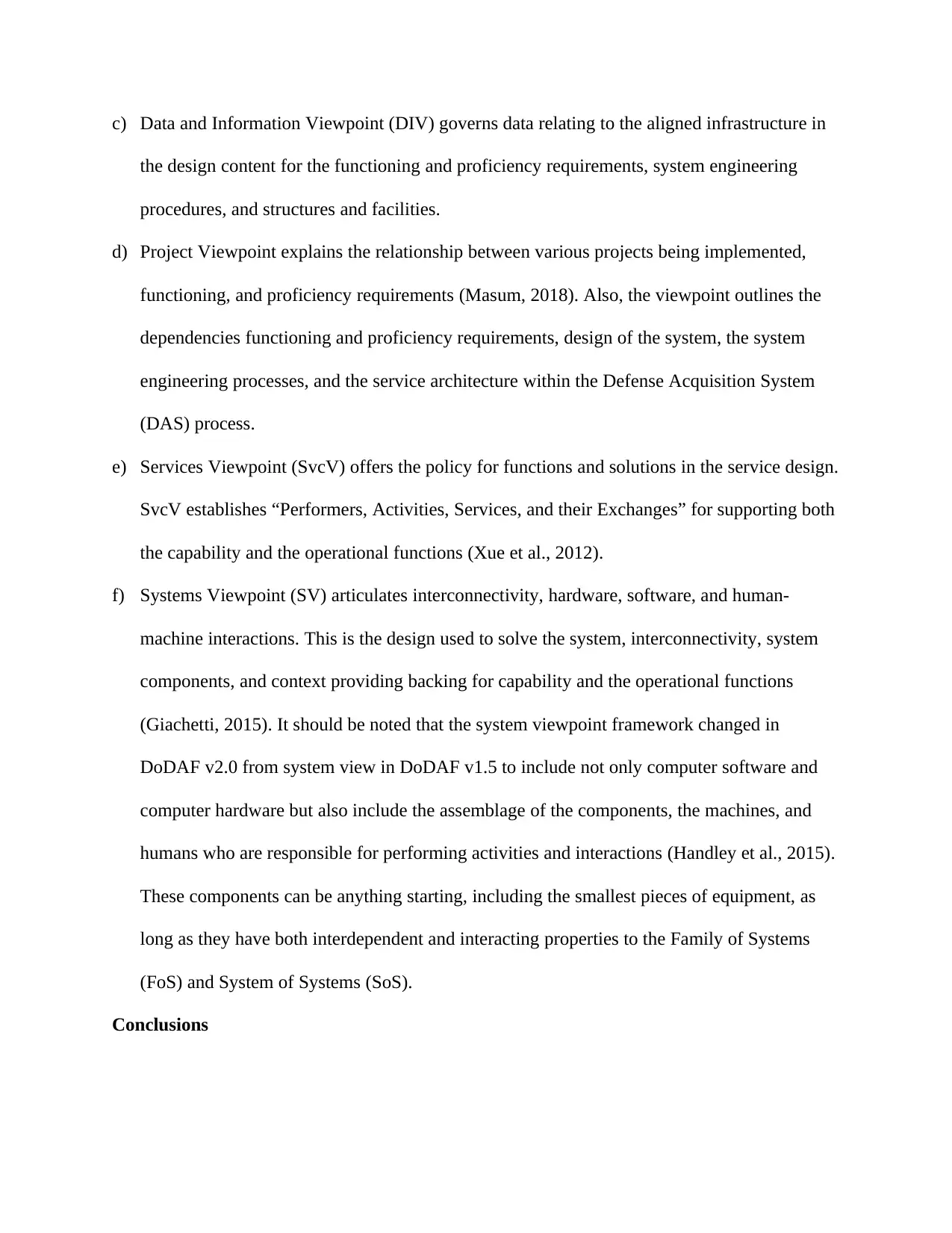
c) Data and Information Viewpoint (DIV) governs data relating to the aligned infrastructure in
the design content for the functioning and proficiency requirements, system engineering
procedures, and structures and facilities.
d) Project Viewpoint explains the relationship between various projects being implemented,
functioning, and proficiency requirements (Masum, 2018). Also, the viewpoint outlines the
dependencies functioning and proficiency requirements, design of the system, the system
engineering processes, and the service architecture within the Defense Acquisition System
(DAS) process.
e) Services Viewpoint (SvcV) offers the policy for functions and solutions in the service design.
SvcV establishes “Performers, Activities, Services, and their Exchanges” for supporting both
the capability and the operational functions (Xue et al., 2012).
f) Systems Viewpoint (SV) articulates interconnectivity, hardware, software, and human-
machine interactions. This is the design used to solve the system, interconnectivity, system
components, and context providing backing for capability and the operational functions
(Giachetti, 2015). It should be noted that the system viewpoint framework changed in
DoDAF v2.0 from system view in DoDAF v1.5 to include not only computer software and
computer hardware but also include the assemblage of the components, the machines, and
humans who are responsible for performing activities and interactions (Handley et al., 2015).
These components can be anything starting, including the smallest pieces of equipment, as
long as they have both interdependent and interacting properties to the Family of Systems
(FoS) and System of Systems (SoS).
Conclusions
the design content for the functioning and proficiency requirements, system engineering
procedures, and structures and facilities.
d) Project Viewpoint explains the relationship between various projects being implemented,
functioning, and proficiency requirements (Masum, 2018). Also, the viewpoint outlines the
dependencies functioning and proficiency requirements, design of the system, the system
engineering processes, and the service architecture within the Defense Acquisition System
(DAS) process.
e) Services Viewpoint (SvcV) offers the policy for functions and solutions in the service design.
SvcV establishes “Performers, Activities, Services, and their Exchanges” for supporting both
the capability and the operational functions (Xue et al., 2012).
f) Systems Viewpoint (SV) articulates interconnectivity, hardware, software, and human-
machine interactions. This is the design used to solve the system, interconnectivity, system
components, and context providing backing for capability and the operational functions
(Giachetti, 2015). It should be noted that the system viewpoint framework changed in
DoDAF v2.0 from system view in DoDAF v1.5 to include not only computer software and
computer hardware but also include the assemblage of the components, the machines, and
humans who are responsible for performing activities and interactions (Handley et al., 2015).
These components can be anything starting, including the smallest pieces of equipment, as
long as they have both interdependent and interacting properties to the Family of Systems
(FoS) and System of Systems (SoS).
Conclusions
Paraphrase This Document
Need a fresh take? Get an instant paraphrase of this document with our AI Paraphraser
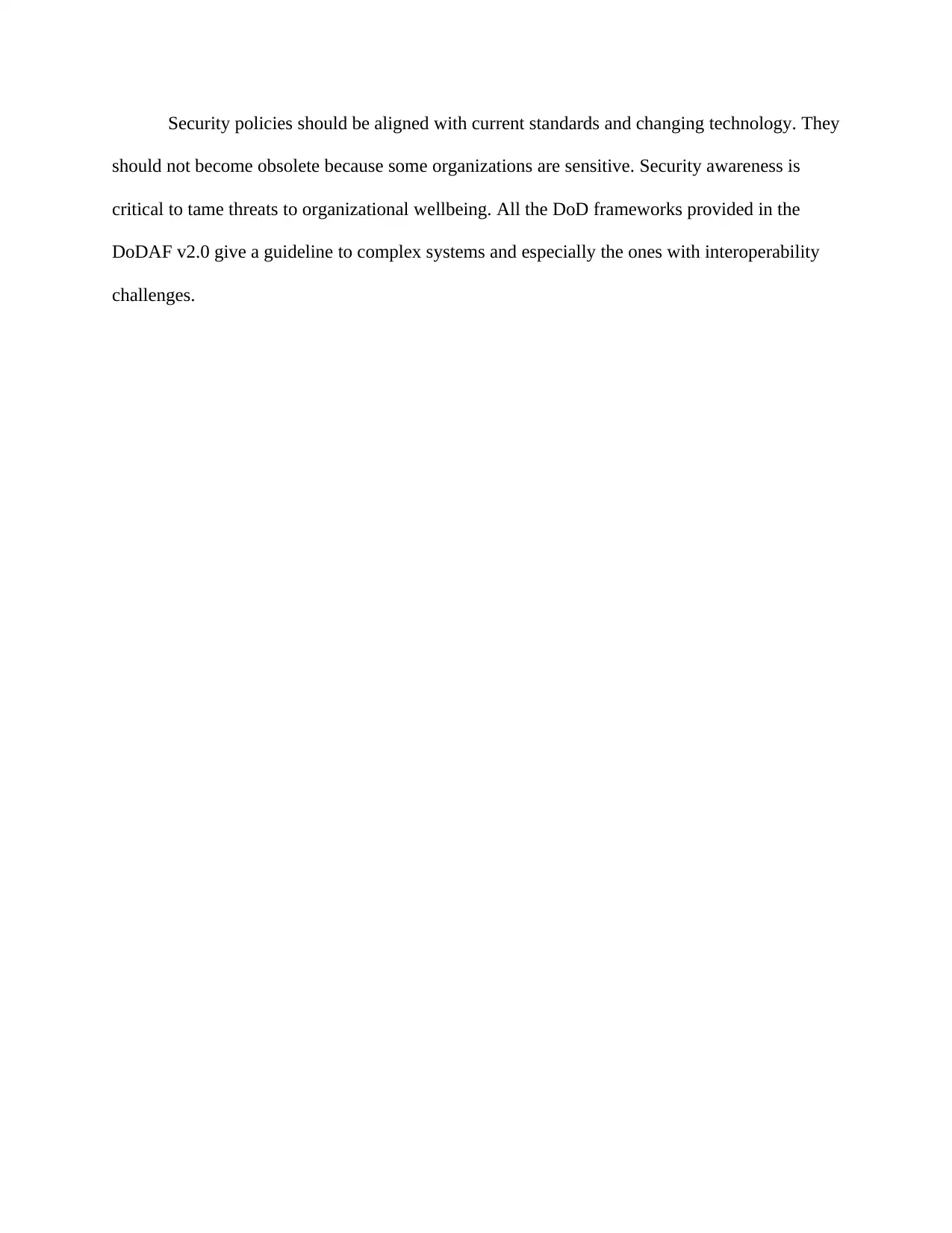
Security policies should be aligned with current standards and changing technology. They
should not become obsolete because some organizations are sensitive. Security awareness is
critical to tame threats to organizational wellbeing. All the DoD frameworks provided in the
DoDAF v2.0 give a guideline to complex systems and especially the ones with interoperability
challenges.
should not become obsolete because some organizations are sensitive. Security awareness is
critical to tame threats to organizational wellbeing. All the DoD frameworks provided in the
DoDAF v2.0 give a guideline to complex systems and especially the ones with interoperability
challenges.
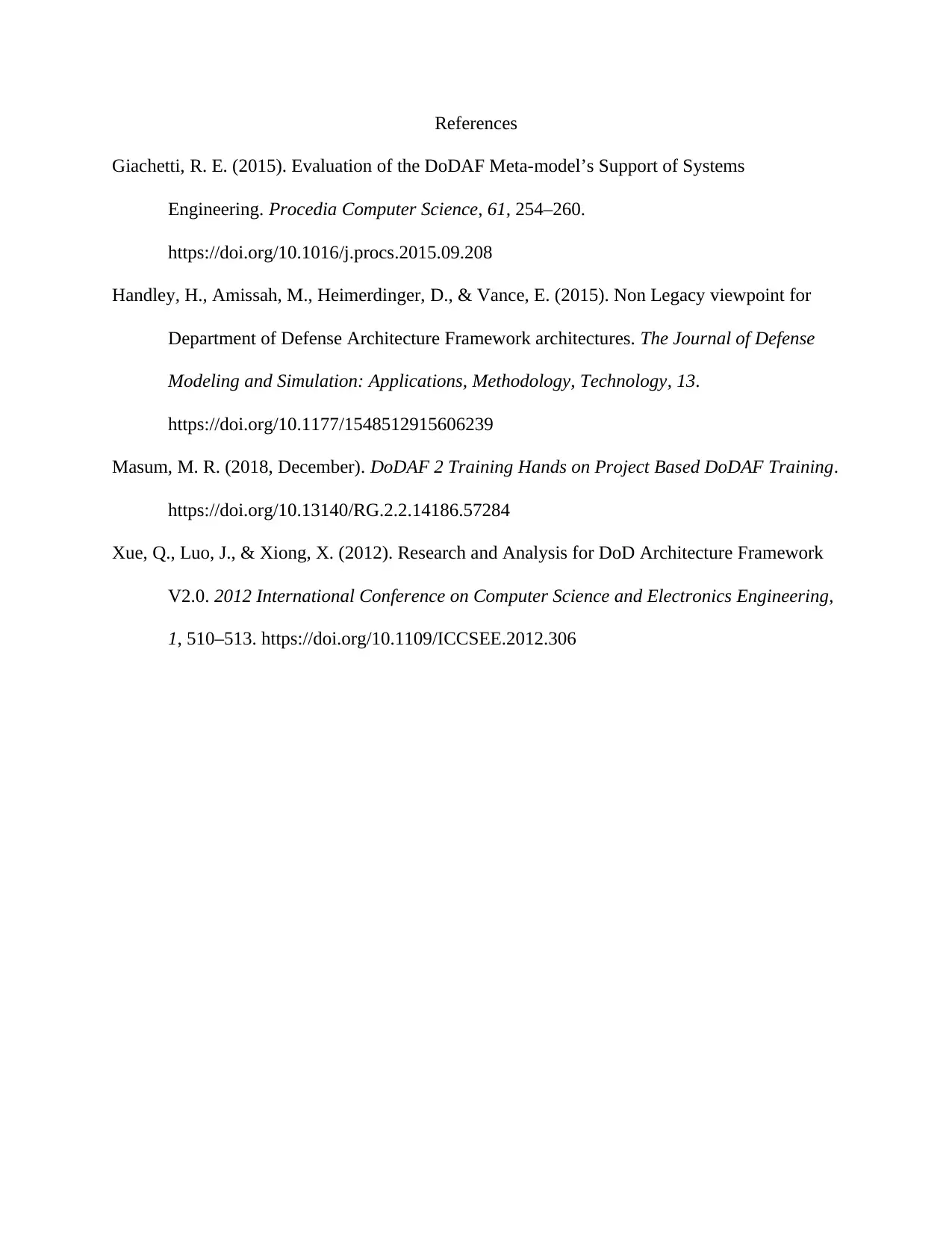
References
Giachetti, R. E. (2015). Evaluation of the DoDAF Meta-model’s Support of Systems
Engineering. Procedia Computer Science, 61, 254–260.
https://doi.org/10.1016/j.procs.2015.09.208
Handley, H., Amissah, M., Heimerdinger, D., & Vance, E. (2015). Non Legacy viewpoint for
Department of Defense Architecture Framework architectures. The Journal of Defense
Modeling and Simulation: Applications, Methodology, Technology, 13.
https://doi.org/10.1177/1548512915606239
Masum, M. R. (2018, December). DoDAF 2 Training Hands on Project Based DoDAF Training.
https://doi.org/10.13140/RG.2.2.14186.57284
Xue, Q., Luo, J., & Xiong, X. (2012). Research and Analysis for DoD Architecture Framework
V2.0. 2012 International Conference on Computer Science and Electronics Engineering,
1, 510–513. https://doi.org/10.1109/ICCSEE.2012.306
Giachetti, R. E. (2015). Evaluation of the DoDAF Meta-model’s Support of Systems
Engineering. Procedia Computer Science, 61, 254–260.
https://doi.org/10.1016/j.procs.2015.09.208
Handley, H., Amissah, M., Heimerdinger, D., & Vance, E. (2015). Non Legacy viewpoint for
Department of Defense Architecture Framework architectures. The Journal of Defense
Modeling and Simulation: Applications, Methodology, Technology, 13.
https://doi.org/10.1177/1548512915606239
Masum, M. R. (2018, December). DoDAF 2 Training Hands on Project Based DoDAF Training.
https://doi.org/10.13140/RG.2.2.14186.57284
Xue, Q., Luo, J., & Xiong, X. (2012). Research and Analysis for DoD Architecture Framework
V2.0. 2012 International Conference on Computer Science and Electronics Engineering,
1, 510–513. https://doi.org/10.1109/ICCSEE.2012.306
You're viewing a preview
Unlock full access by subscribing today!
1 out of 6
Related Documents
Your All-in-One AI-Powered Toolkit for Academic Success.
+13062052269
info@desklib.com
Available 24*7 on WhatsApp / Email
![[object Object]](/_next/static/media/star-bottom.7253800d.svg)
Unlock your academic potential
© 2024 | Zucol Services PVT LTD | All rights reserved.



